(25th Home) (1963-1986) (1986-1994) (1994-2001) (2001-2005) (2005-2007) (2007-2013)
The Foundation Years
Once the decision was made to establish a state-funded supercomputer center that would rival national labs recently erected elsewhere, several key players set up shop on the OSU campus. Within a short two years, they would boast of having the fastest supercomputer in the world, a statewide communications network and an interdisciplinary research center for computer graphics, animation, visualization and multimedia.
Ohio Approves OSC
The idea of establishing a supercomputer center in Ohio appears in Governor Richard Celeste's 1987 state-of-the-state address:
“To attract and retain industry, we must have the most sophisticated and advanced computer technology possible,” he said. “The Ohio Board of Regents has organized a consortium of universities to buy a supercomputer. I will recommend funding for that supercomputer to link our universities and industries, giving researchers an essential tool to conduct the most basic scientific research and to solve the most practical design and manufacturing problems of our industry.”
By 1987, Lawrence Anderson at the University of Toledo was researching the atmospheres of stars using a supercomputer at the National Center for Atmosphere Research in Boulder, Colo., and often waited weeks or months to receive a printout of his data. At Ohio University, researchers already working with a national supercomputer center were analyzing and predicting nuclear reactions induced by gamma rays and high-energy electrons. Ohio State researchers were creating supercomputer programs to produce three-dimensional images in real time by analyzing the masses of data obtained from CAT scans and MRIs. Chemists at OSU were using supercomputers to model molecules allowing drugs and other chemicals to be designed more efficiently.
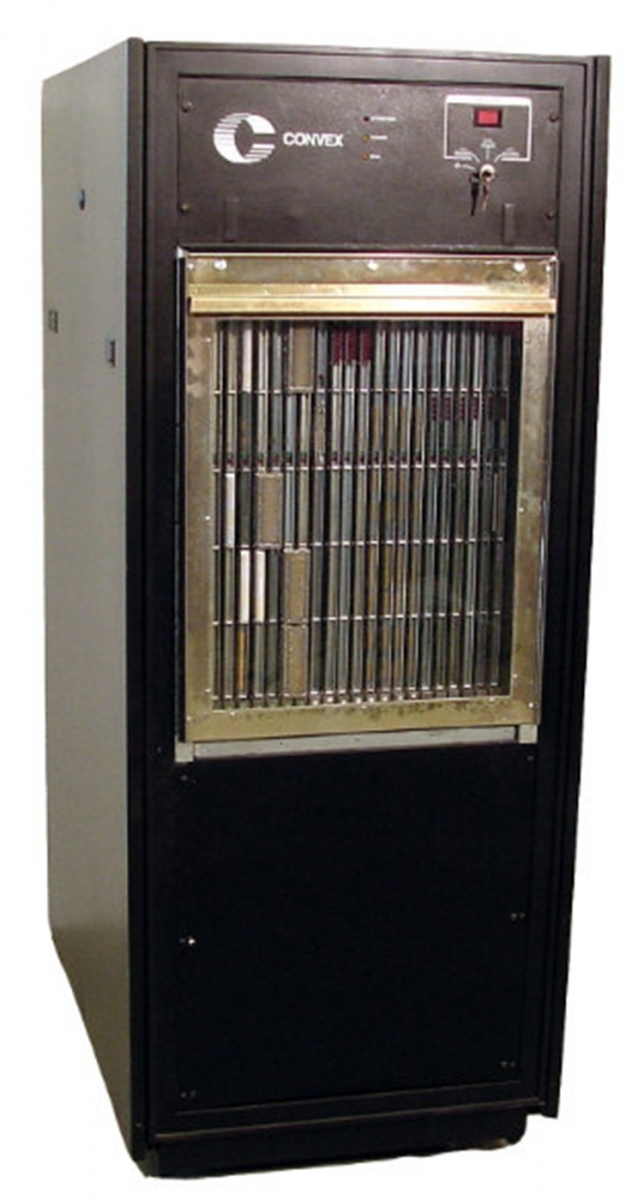
In the spring of 1987, OSP installed a Convex C-1 computer, representing an interim step to the next generation of supercomputers to be acquired, according to Csuri. The C-1 operated at only one-fifth the speed of the smallest supercomputer, but it was 50 times faster than equipment then available at OSU. It allowed Csuri’s group to develop new types of supercomputer software, displaying the potential for supercomputer graphics across a wide range of scientific specialties.
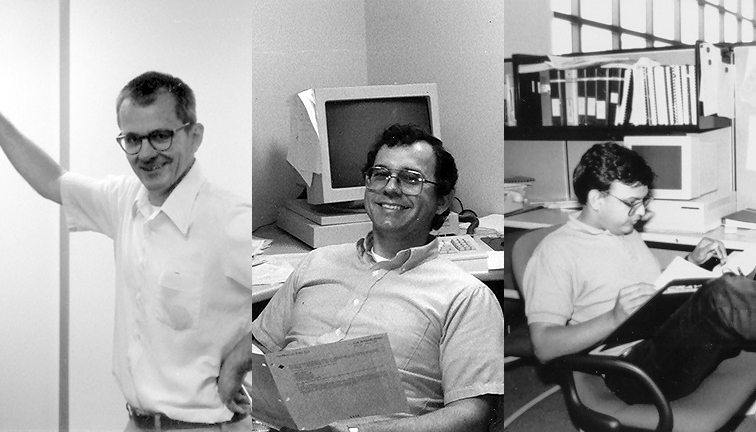
That spring, BOR helped establish the first staff at the center by awarding $4 million in Research Challenge Grant funds. OSU hired the first OSP technical staff employees – Paul Buerger, Sam Bair and Raghu Machiraju – and OSP offices were established at Smith Laboratory on the OSU campus. Also, an office was established at OSU for Cray consultants Kevin Wohlever, Brent Anderson, Jim Garman and John Marinchek.
In anticipation of state funding later in the year to cover personnel costs, Ohio State budgeted $8.2 million over the next five years to lease a Cray X-MP/24, OSP’s first real supercomputer in the spring of 1987. The X-MP arrived June 1 at the OSU IRCC loading dock on Kinnear Road.
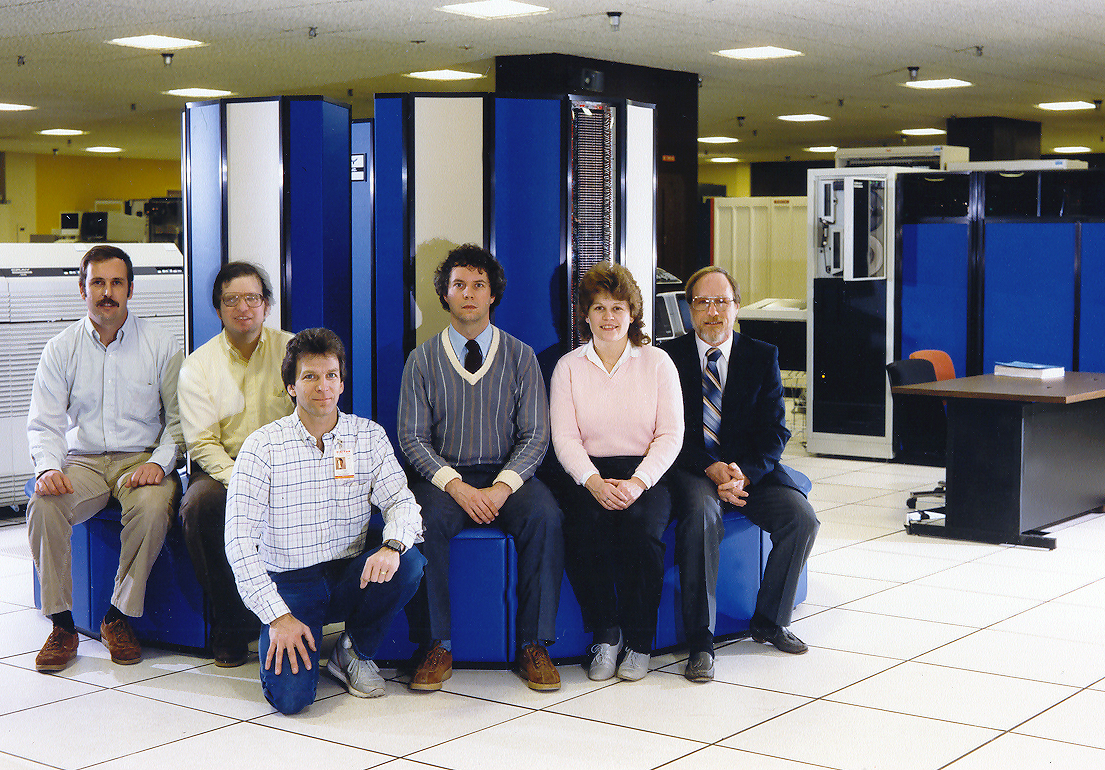
That same month, the first segments of a network to connect university researchers to the supercomputer were installed using microwave and fiber optic lines, piggybacking on state’s SONIC telecom network. Tim Steiner, of the Ohio Department of Administrative Services, made the state’s contract with Litel Communications, a fiber-optics company, available for OARnet use. One early suggestion for naming the academic network in a fashion similar to the state network – State of Ohio Network for Academic Resources (SONAR) was not accepted at the BOR until the words were rearranged to Ohio Academic Resources Network (OARnet). The name was purposely chosen to emphasize that the network was available for all academic purposes, not just supercomputer access.
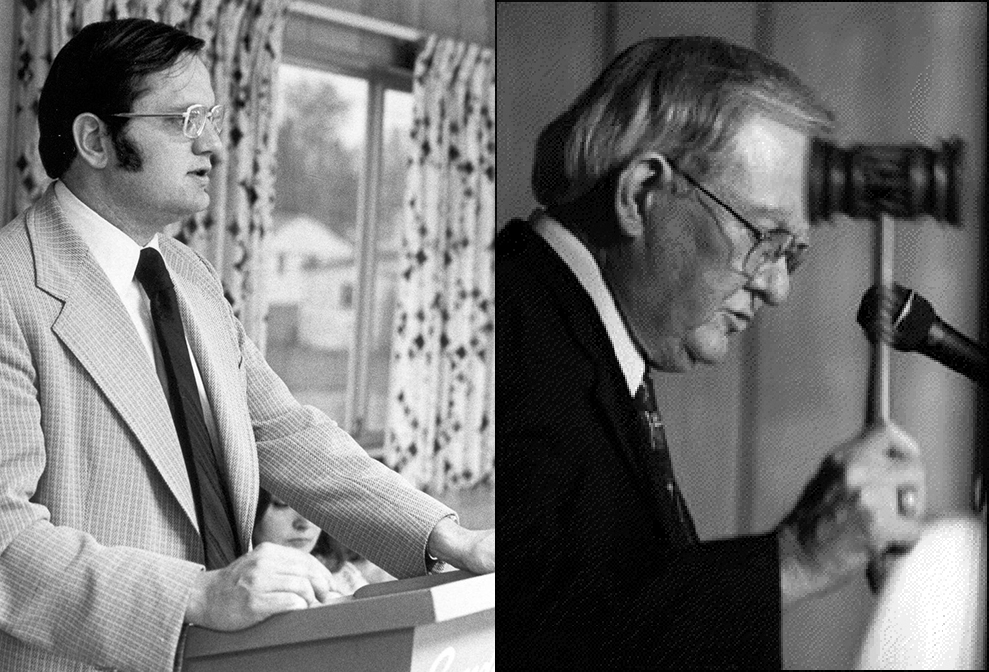
On the last day of June 1987, the Ohio General Assembly passed the state operating biennium budget bill, thereby creating the Ohio Supercomputer Center and providing $7.5 million to fund center operations. The allocation is contained in House Bill 171, specifying that the allocation “shall be used by the Ohio Board of Regents to support the operation of the center, located at The Ohio State University, to be developed as a statewide resource available to Ohio research universities both public and private. It is also intended that the center be made accessible to private industry as appropriate.”
OSC and OARnet Join Forces
In July, the center established its first helpdesk with a Bitnet address of OSCHELP at OHSTVMA. A special IEEE magazine that month carried a feature article and cover illustration from the Computer Graphics Research Group.
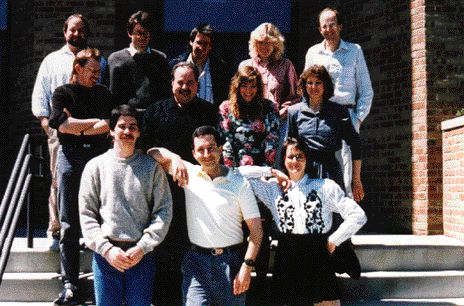
Thomas Linehan and Csuri soon converted CGRG into ACCAD with funding from a long-term BOR Academic Challenge grant. ACCAD is to provide computer animation resources in teaching, research and production for all departments in the College of the Arts at Ohio State. Also, the Ohio Supercomputer Graphics Project was established as a visualization development initiative of OSC with Csuri as its director. Stephen Anderson, Scott Dyer, Jeffrey T. Faust, Robert E. Marshall, John Andrew Berton Jr., Peter G. Carswell and Barbara Helfer-Dean were hired to create the first staff of OSGP.
In September 1987, Pitzer was serving as director of OARnet and authored a charter, which was adopted by the interim Governing Board at their meeting in November. The charter provided for Statewide Network Users Committee (SNUC) and gave official status to the already existing statewide Technical Committee.
- The purpose of the Ohio Academic Resources Network (OARnet) is to facilitate and encourage the development and dissemination of knowledge throughout the state, and by connections with other networks, nationally and internationally. All Ohio academic institutions are encouraged to participate, and other Ohio organizations are encouraged to participate in connection with their research and academic endeavors.
- By means of communications links between computers at research and educational institutions, OARnet will provide access to specialized computer facilities and data at distant locations, and provide for efficient data transfer of all kinds between institutions, including research data files, electronic mail, instructional information, manuscripts, library information, graphics, and video. A prime goal of OARnet will be to facilitate and encourage both collaborative projects between institutions and the general sharing of resources.
OSC “accepted” the X-MP system from Cray on Oct. 10 after several troublesome software difficulties were solved, just in time to plan for a Nov. 2 dedication ceremony for the new system. At the event, Cray announced a $1 million commitment to provide grant support for software development on the X-MP.
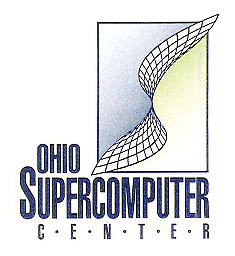
OSC's First Governing Board
On Dec. 18, a BOR resolution officially established OSC and created its first permanent governing board: Jennings (president), Klopman, Muse, Ping, Ruppert, Steger, Coulter, Paul, Peterson and Hollander. In part, the resolution stated:
“WHEREAS, the State of Ohio has established an Ohio Supercomputer Center as a statewide resource designed to place Ohio’s research universities and private industry in the forefront of computational research … the Ohio Board of Regents hereby establishes the Ohio Supercomputer Governing Board … that the Center will be a unit within and operated for the State of Ohio users of the Supercomputer, by The Ohio State University …that a network established by the Center will provide communications links from the Center at Ohio State to the campuses of member Ohio academic institutions …that a supercomputer training program will be conducted by the Center.”
At this time, additional researchers flocked to OSC. Sherwin Singer, in chemistry at OSU, was planning to use the supercomputers in statistical mechanics and photo-dissociation work. Bill Kern, who recently joined OSU as dean of Mathematical and Physical Sciences, had used them in cluster studies while he was at NSF and at the Office of Science and Technology Policy.

In February 1988, Ohio Governor Richard Celeste committed his administration to funding a new Cray supercomputer for OSC in a speech at the AAAS meeting in Boston: “We know we’re committed, and they (Cray) know we’re committed.” In March, the 117th Ohio General Assembly authorized the purchase of a $22-million Cray Y-MP through House Bill 810, a capital appropriations bill.
The staff of OSC was moving ahead with operational details. The first published use of the network name OARnet came in March 1988, and Earl Holland at OSU and Kate Carey at BOR were handling media relations efforts for the center. The following month, April 1988, Charles Bender was named director of OSC, as well as director of OSU Research Computing, and a year later, he was named director of OSU Academic Computing, to oversee “all centrally funded academic computing activities” on the Ohio State campus.
The center held the first meeting of the Statewide Network Users Committee (SNUC) in May. Later, this group would become the OARnet Steering Committee (OSTEER), composed of school representatives who consider fees for Internet access and discuss OARnet policies. In 2011, Chancellor Eric Fingerhut replaced OSTEER meetings with OARnet Member meetings.
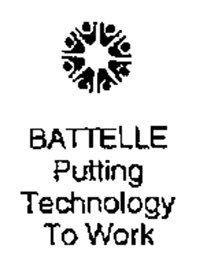
That summer, OSC launched the center’s Industrial Interface Program to serve businesses interested in accessing the supercomputer. Battelle Memorial Institute, located just south of OSU, became OSC’s first industrial user. The center also created OSC created the Ohio Visualization Laboratory that year. The Computer Graphics Research Group moved to newly renovated space at 1224 Kinnear Road, while OSC offices were moved to nearby space at the Research Foundation on Kinnear Road.
1988 Symposium on Supercomputing
On Sept. 8-9, 1988, OSC held its first Symposium on Supercomputing. During the conference, OSC officials shared with attendees the official charter of the center:
The Ohio Supercomputer Center was established in 1987 to position Ohio universities and industries at the forefront of computationally intensive research, development and engineering. To accomplish this prominence, the Center concentrates on five interconnected objectives:
- To provide supercomputer services to Ohio scientists and engineers;
- To stimulate unique uses of supercomputers in Ohio;
- To attract students, faculty, resources and industry;
- To catalyze inter-institutional supercomputer research and development projects; and
- To serve as the model for other state-sponsored technology initiatives.
- The Ohio Supercomputer Center is dedicated to demonstrating Ohio’s leadership in and commitment to science and technology.
In that same month, OSC staffers began publishing the newsletter Superbits, and its research and public relations newsletter, Visions. Within a year, the Center began publishing inserts for the Superbits newsletter, one called OARacle for networking topics, and another called apEvine for visualization news.
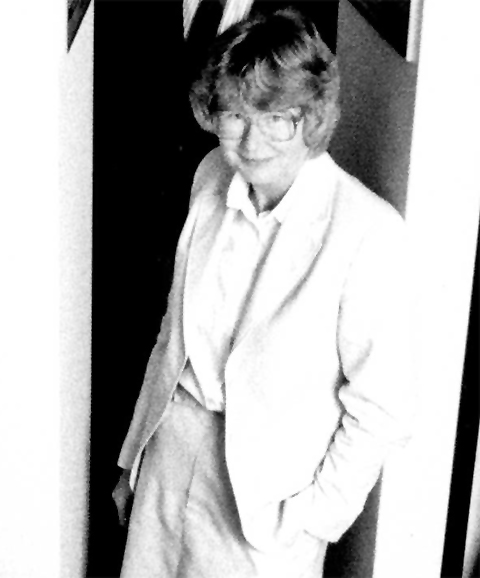
In 1988, Alison A. Brown left Cornell University to take the position of associate director of OSC, in charge of networking initiatives. She also was associate director of research computing at OSU. Her husband and physicist, 1982 Nobel Prize winner Kenneth Wilson, also moved to a post at OSU. Brown subsequently located the OARnet offices at the building on North Star Road, as she built up the OARnet staff. Later, OARnet also acquired some office space in nearby buildings on Lane Avenue.
In October, the staff in OSC Networking established osc.edu as the domain name for OARnet, and, in November, OSC created the Performance Analysis Tools Team.
In the spring of 1989, Governor Celeste announced the OSC Super Challenge Ohio, a contest to win industry cycles on the center’s Y-MP system. In May 1989, the Supercomputer Users Group created the Visitors Program and Visualization Visitors Program.
OARnet, by this time, was connected to the National Science Foundation’s NSFNET, which yielded a secondary connection to Bitnet and primary connections to CSNet, SPAN, HEPNET, MILNET, the DDN and the new Defense Research Internet, which replaced ARPANET.
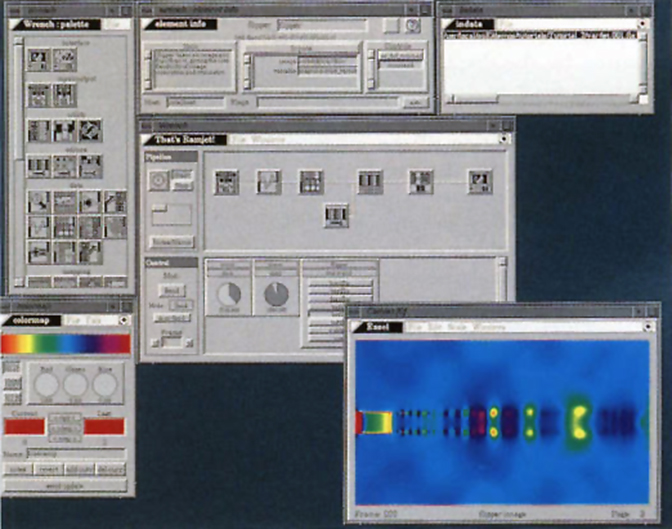
apE Software
In 1989 the Animation Production Environment (apE) 1.0 was released to all OSC users from OSGP. In late July, this software was placed in the public domain and made available by tape or anonymous FTP for all academic and research users in the world. Dr. G. Comer Duncan of Bowling Green State University helped the OSGP staff debug the first release. Cray Research, Apple Computer and Silicon Graphics supported the development of apE.
apE was originally distributed free of charge to any users who wanted to use it, and it allowed for these users to write their own modules to extend the capabilities. apE was the precursor for several commercial scientific visualization products, including AVS and Explorer. Within a year, OSC would begin shipping apE 2.0 with more than 300 orders in the queue. Each apE tape contained more than 100 megabytes of executables, demonstrations and source code, requiring approximately 30 minutes to produce each tape.
In 1991, OSC decided to commercialize this popular free software, and contracted with Taravisuals, Inc. to maintain and distribute it. Unfortunately, at about the same time, Iris Explorer was released and was freely bundled with the SGI workstation, one of the more popular apE platforms, and the apE effort was discontinued.
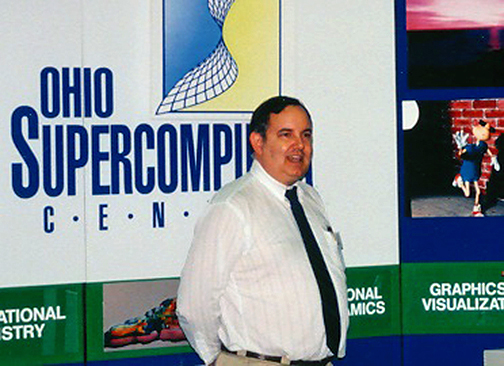
Educational Outreach at OSC
The summer of 1989 featured 20 talented high school students attending the first Governor’s Summer Institute, which marked the beginning of OSC’s legacy of educational outreach. Fred Crowner of the Center’s User Services staff coordinated that first SI, held from July 17-28. The objectives of GSI were:
- To explore high-end workstations and supercomputers
- To show how supercomputers impact science, industry and art
- To show the importance of computer-generated visualization
- To provide each student with access to the CRAY Supercomputer
- To provide each student with a video tape showing his or her activities
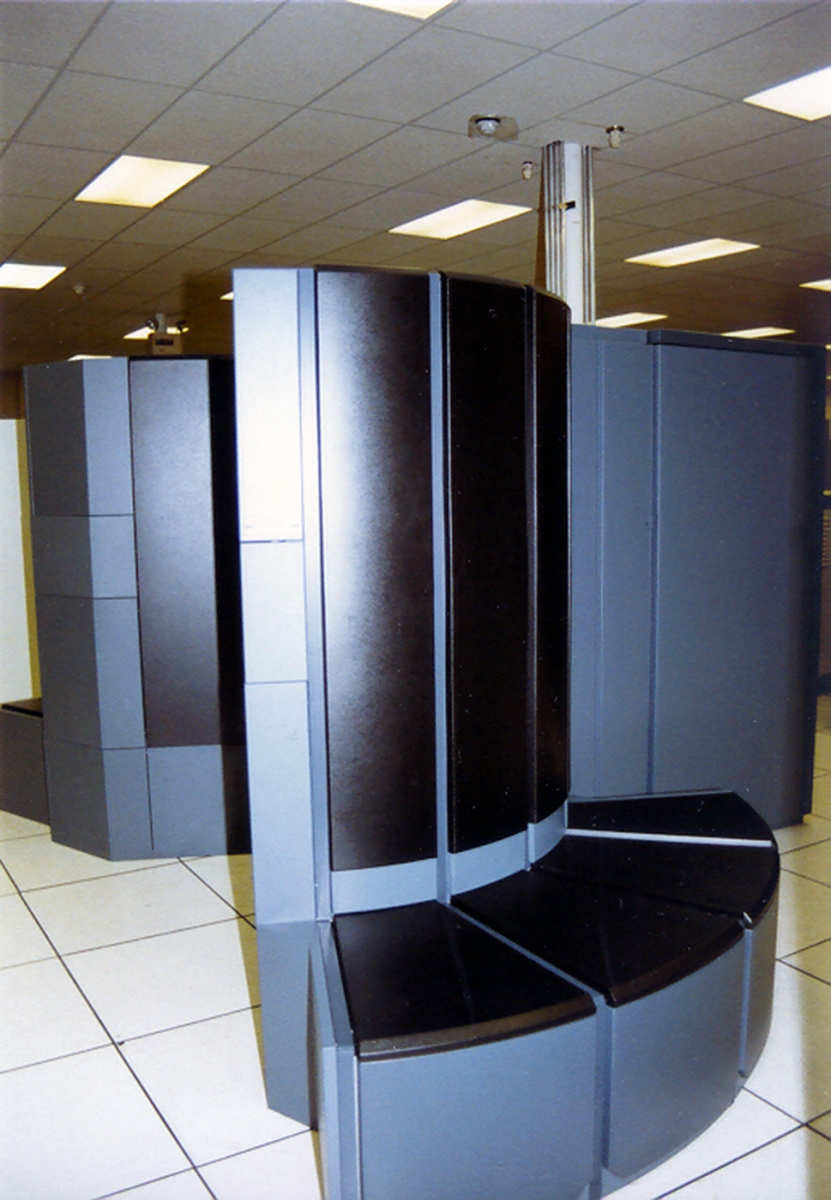
In August 1989, OSC engineers completed the installation of the $22 million Cray Y-MP8/864 system, which was deemed the largest and fastest supercomputer in the world for a short time. The seven-ton system was able to calculate 200 times faster than many mainframes at that time and underwent several weeks of stress testing from “friendly users, who loaded the machine to 97 percent capacity for 17 consecutive days.
“The lightning speed of the supercomputer allows scientists to work massive problems in real-time, without having to wait days or weeks for the results of larger computer runs,” according to a Sept. 28, 1989, article in Ohio State’s faculty and staff newsletter, OnCampus. “The CRAY Y-MP8/864 performs 2.7 billion calculations per second.”
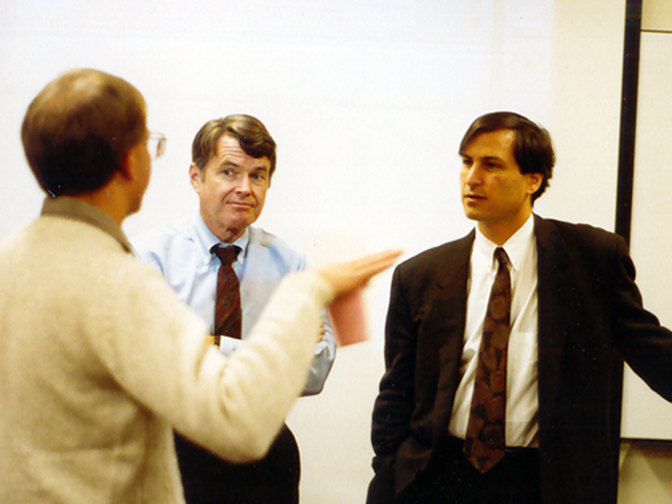
Late 1989 was a time for VIP visits to OSC. The first, on Oct. 20, was a meeting with a young businessman, Steve Jobs, to discuss technical issues with NeXT users at the center. Then, on Oct. 25, Governor Celeste attended a dedication ceremony for the Cray Y-MP system.
That same year, OSC became a founding member of the Coalition of Academic Supercomputer Centers (CASC). CASC advocates for “the use of the most advanced computing technology to accelerate scientific discovery for national competitiveness, global security, and economic success, as well as develop a diverse and well-prepared 21st century workforce.”
OARnet adopted the Transmission Control Protocol/Internet Protocol (TCP/IP) package in 1989 to specify how data in network communications should be formatted, addressed, transmitted, routed and received, as well as Simple Network Management Protocol (SNMP) to monitor network traffic and line failures. The spread of TCP/IP was fueled in June 1989, when AT&T agreed to put into the public domain the TCP/IP code developed for UNIX.
Throughout the late 1980s, Gregory D. Burns, a senior software engineer at OSC, led the development of the Local Area Multicomputer (LAM). LAM is a programming environment and development system for heterogeneous computers on a network, a predecessor for MPI for supercomputer communications.
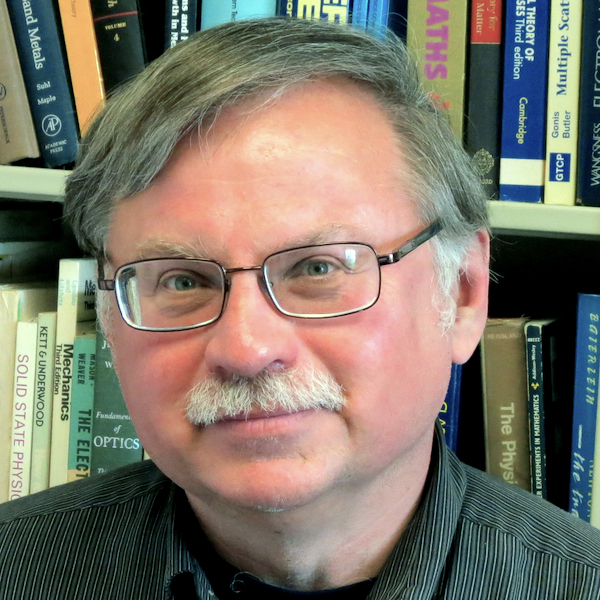
The 1990s Bring Big Changes
The next decade started off with a bang, when University of Cincinnati (UC) Physicist Frank J. Pinski received the Gigaflop Performance Award from CRAY Research shortly after he achieved a 1.5 gigaflop run of his code on OSC’s Cray Y-MP system, establishing the fastest computer run in the world. Pinski, working with UC graduate student William Shelton and colleagues from Oak Ridge National Laboratory, Daresbury Laboratory in England and OSC user services staff, modified his existing code for calculating the electronic structure of solid solutions.
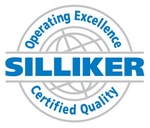
Also near the beginning of 1990, Silliker Laboratories Inc. opened down the hall at 1224 Kinnear, providing inspections and quality control services for the food industry, including dairies, meat packagers and food processing plants. The facility also often provided OSC staff members with a novel and fragrant olfactory environment in which to work.
In May 1990, Martha J. Lobdell was brought onto the OSC staff to help sell time on the Y-MP to business clients. Twelve companies were using the Cray supercomputer at the time. According to Columbus Business First, “the cost per hour for using the supercomputer has declined substantially since last year. At that time, businesses were charged $1,000 per hour to offset the costs of running the machine. With more processors that work 40 percent faster, time on the Y-MP is now $770 per hour.”
By fall, OARnet had deployed a statewide network backbone capable of transmitting data at 1.544 megabits per second, an increase from the low-speed 9.6 kilobits per second or medium-speed 56 kbps. While most of the applications used up until that time – email, file transfer and remote login – did not require high-speed connections, the new T1 network would offer clients the opportunity of new applications, such as “interactive remote supercomputer visualization.” Schools in Northeast Ohio began using equipment placed at telephone company points of presence (POPs), resulting in savings due to connection points that were closer than Columbus.
In September, OARnet received a National Science Foundation grant of $110,000 to establish and upgrade network connections. With the NSF funds, OARnet connected Muskingum College, Ohio Northern University, Shawnee State University, Sinclair Community College and Wilberforce University. Central State received funds to purchase routers that would run the TCP/IP protocol.

In December 1990, Ohio State took over management of the CICNet network, linking Big Ten universities, University of Chicago and other universities, labs and corporations. OARnet provided its clients with connections to a number of regional and national networks, including CICNet, the first regional network composed of all T1 circuits.
OSC deployed the Storage Technology Corporation (StorageTek) tape silo system in January 1991. With a capacity of 1.2 terabytes, the system held up to 6,000 tape cartridges. The silo system was connected directly to the Cray and represented the first step toward a mass storage system at the Center.
Later that spring, SUG began offering Optimization Awards to the Center’s users. Winners were awarded 100 resource units each, while Honorable Mention recipients were awarded 50 resource units each. The criteria for the optimization awards included:
- Overall documented speed
- Documented improvement
- Innovation and improvement
- Scientific/engineering relevance of calculations
OARnet in Commercial Service
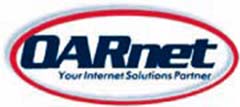
On May 31, 1991, the Policy subcommittee of OSTEER meets at OSU-Mansfield to discuss the issue of commercial traffic on OARnet. NSFNET and academic networks like OARnet had generally restricted connections to education and research organizations, as well as governmental organizations that dealt with these groups. Allison Brown sent OSTEER a one-page summary of the issue, pointing out that NSFNET had grown enough that NSF felt that commercial services could take it over and expand the use of the network. The subcommittee meets and recommends allowing commercial traffic on OARnet, and OSTEER subsequently agreed. OARnet then hired a salesman, becoming perhaps the first Internet Service Provider in Ohio, and started signing up commercial accounts. After a few months, telecoms became very active in the field, the OARnet salesman was hired away by one of them and OARnet decided not to compete with the telecoms further in signing up new customers, but continued to provide services to existing customers as long as it was desired.
OARnet received a $71,000 grant from the National Science Foundation in July 1991 to establish connections for Antioch College, Heidelberg College and Ohio Wesleyan University. That summer, OARnet began offering dial-up connections to the network with numbers in Columbus and Cleveland. Additional locations were planned for major metro areas around the state in response to customer demand. The following summer, OARnet began offering toll-free dial connections to the network.
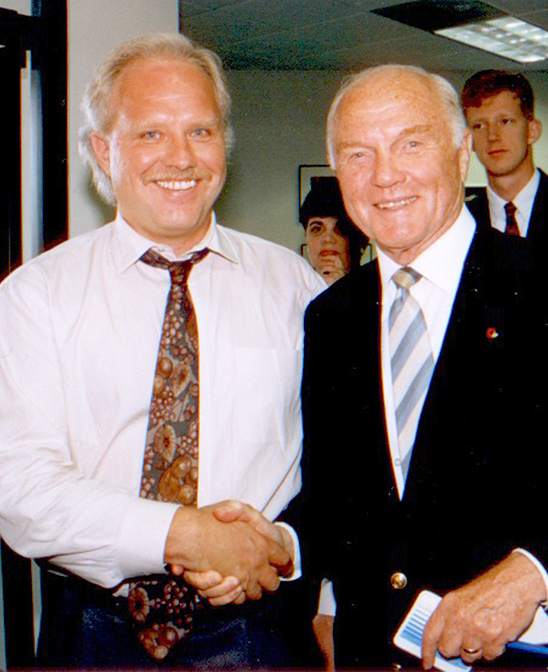
Changes, Expansions Continue
In 1991, Wayne Carlson was named director of ACCAD, following the retirement of Chuck Csuri at the end of 1990.
In June 1992, OSC installed the center’s first mass storage system, increasing data storage capacity to 1.2 terabytes. The main components of the system were:
- A Cray Y-MP EL, a small computer that serves as the central platform for the system, controlling the software that tracks data and moves files around the various storage media.
- A file cache, housed in the EL, acting as a temporary storage area between the Y-MP8 and the high density, low cost storage of the StorageTech tape silo.
- The StorageTech tape silo deployed in 1991.
- A High-Performance Parallel Interface (HIPPI) channel capable of transferring 32 bits of data in parallel.
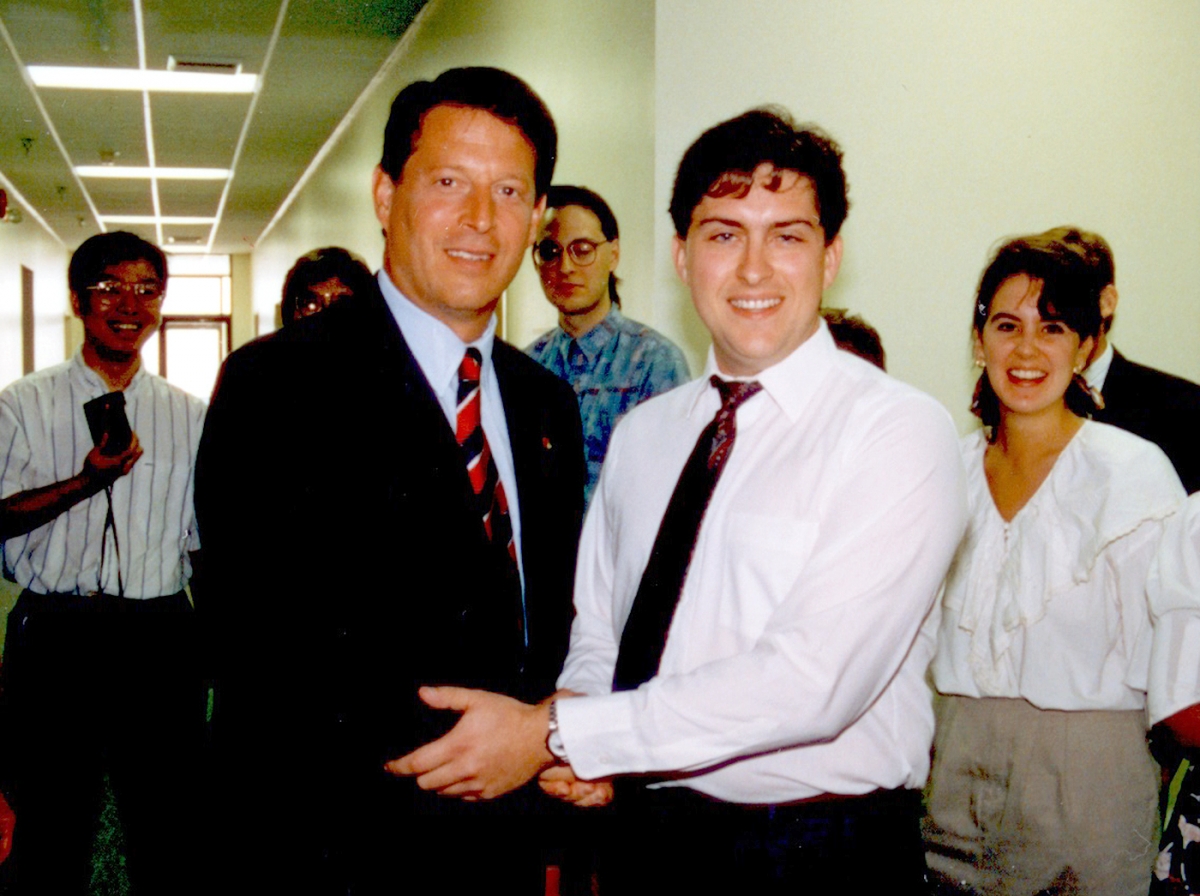
On Aug. 25, 1992, Senator Al Gore, who was campaigning for vice president, visited 1224 Kinnear, with Senator John Glenn among Ohio’s welcoming dignitaries. Gore, who had carved a niche for himself in Congress on science and technology issues, “promoted legislation aimed at creating what he called superhighways of computer information that would improve business efficiency and international competitiveness,” according to an article in the Chicago Tribune. “[The technology] would create millions of new, high-wage jobs to take the place, and then some, of those that have been lost during the last four years,” the article quoted Gore as saying.
In the spring of 1993, OARnet began offering network application services, including set-up of electronic mail, domain name service (DNS), special security options and information servers on campus UNIX systems. Another NSF grant allowed OARnet to establish connections with Baldwin-Wallace College, Capital University, Cedarville College, University of Findlay, College of Mount St. Joseph and Xavier University.
OARnet established the Network Information Services help desk service in 1993 and installed a second T1 line to the OARnet/Advanced Network and Systems (ANS) gateway in Cleveland. In the fall, OARnet began offering ISDN services and implemented the use of Gopher Internet information servers.
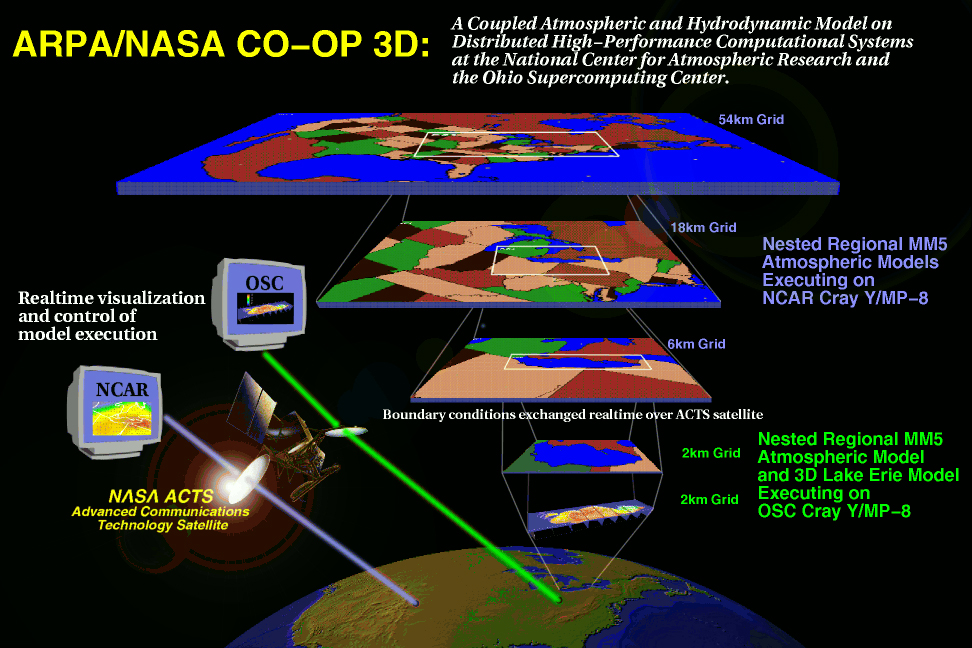
In 1993, OSC’s Biomedical Applications Research group, an interdisciplinary group comprising faculty, research scientists, and clinicians, was created to apply high performance computing and advanced interface technology to the virtual exploration of complex computational data, specifically biomedical information. To effectively use this information, group members leverage various types of interface equipment, including stereo imaging, voice interaction, instrumented gloved interfaces, and specialized equipment that resembles actual medical equipment.
That September, OSC and ACCAD participated in two Advanced Communications Technology Satellite experiments. One of the projects was designed to help forecast changing weather patterns in the Great Lakes region, and the other to simulate a natural disaster in a rural or isolated location, and the subsequent need for medical triage, diagnosis and treatment planning. Primary OSC personnel involved in the project were Alison Brown, Paul Buerger and Kevin Wohlever, while Wayne Carlson was the primary ACCAD participant, and Keith Bedford from the Department of Civil Engineering was the main OSU participant.
Also in the fall, NSF grants funded new OARnet connections at Columbus State Community College, Edison State Community College, Hocking College, Kent State University – East Liverpool Campus, Lakeland Community College Mount Vernon Nazarene College and Southern State Community College.
(25th Home) (1963-1986) (1986-1994) (1994-2001) (2001-2005) (2005-2007) (2007-2013)

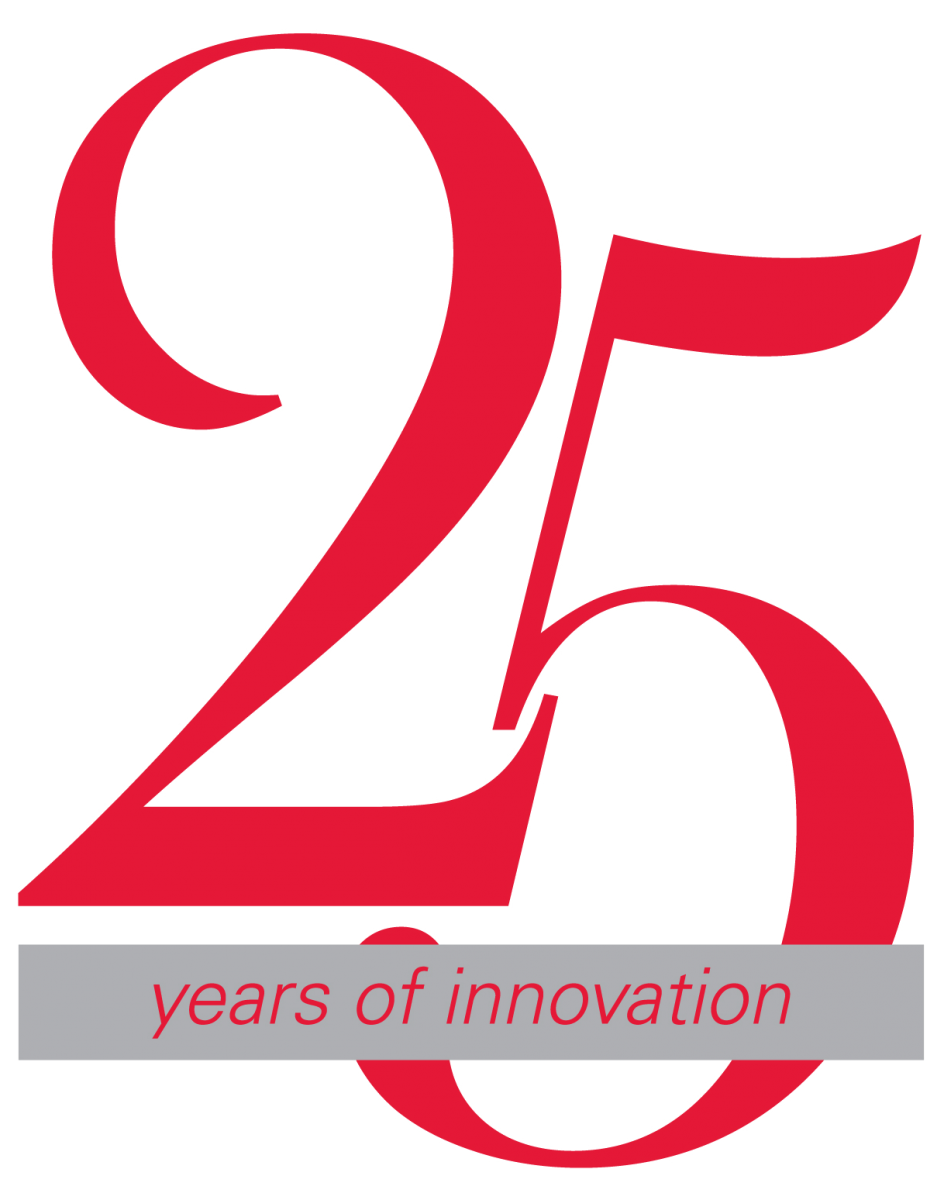
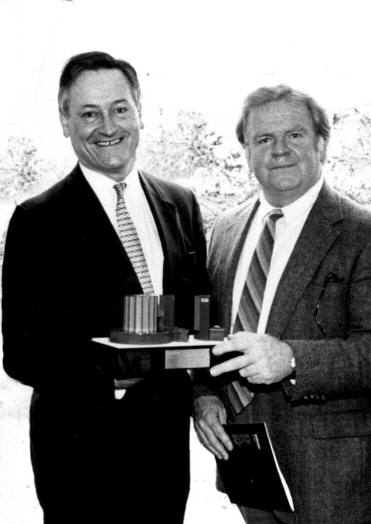
 (December 5)
(December 5)
 (November 18)
(November 18)